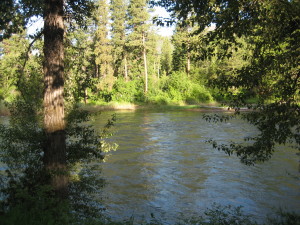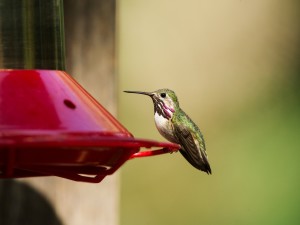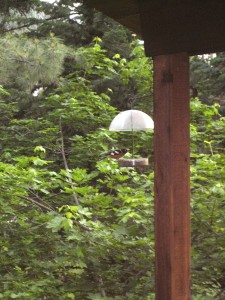June 20, 2014 – Arrived here in Missoula to marvelous fresh air. It’s been raining for a week and now everything sparkles and the Douglas-Firs shine green and the meadows are full of wildflowers. Nothing can compare with late June in the northern forest.
The Blackfoot River runs high and swift in this part of the canyon. We watch the water’s movement, roiling around rocks and logs, lolling in deep pools; always changing with the weather. What color is it? Gray, green, pale white, or silver?
This afternoon is so extraordinarily mild and lovely. The sun filters through the firs. The air is like ambrosia — dry and fine. The ground beneath, moistened from last night’s rain, sprouts wildflowers in the fields.
The bird song fills me with happiness. I couldn’t recognize some of the calls and songs at first, but most of them were familiar enough that I could walk down the road out in front of the house and call out the species to myself.
The feeders on the deck attract Pine Siskins and Cassin’s Finches.
But the big news is the abundance of Evening Grosbeaks! It takes your breath away to see their bright yellow and black and white. They wield over-sized bills for cracking pine seeds, or sunflower seeds at the feeders.
Watching at the bird feeders is so much fun: the Evening Grosbeaks are a bowl of yellow and black, a collection of jewels. Big, chunky jewels. With a lot of arguing and squabbling among them.
I love the burgeoning feeling of all of these birds that’ve just arrived from the south for the nesting season. This is the brief moment in time when it all happens and then ? They’re gone, gone, gone. And you think it’s OK if you wait til July or August to visit here but it’s not OK. You’ll miss the dawn chorus of American Robins, Western Tanagers, and Black-headed Grosbeaks. You’ll miss the male Calliope Hummingbird that perched on a wire over the road this afternoon. And the Cordilleran Flycatcher that sings it’s quick “zeeeeep?” Just slightly different enough from our Pacific-slope Flycatchers back home to make me look at the range map & confirm that indeed this is Cordilleran country.
Other birds heard and seen are Warbling Vireo, Cassin’s Vireo, and Western Wood-Pewee, along with lots of Yellow Warblers. Oh, and the Yellow-rumped Warblers are here, too. And how recently they left our Santa Barbara chaparral for breeding grounds here in the green-branched conifers.
Bird list June 20, 2014:
Common Merganser – 1 female with 3 juveniles on the river
Spotted Sandpiper – 2 (a pair?) calling to each other from a log on the far bank
Calliope Hummingbird – 1 male perched on wire over road
Belted Kingfisher – 1 (heard in distance)
Northern Flicker – 2
Western Wood-Pewee – 2
Cordilleran Flycatcher – 1
Black-capped Chickadee – 2
Red-breasted Nuthatch – 2
American Robin – ~10-12
Hermit Thrush – 1
Cedar Waxwing – ~ 12-14 (includes 1 adult at nest)
Warbling Vireo – 4
Cassin’s Vireo – 2
Yellow Warbler – 4
Yellow-rumped Warbler – 4 (nest with 3 nestlings found 2 days later but not counted here)
Western Tanager – 3
Black-headed Grosbeak – 2
Spotted Towhee – 2
Song Sparrow – 3
Brown-headed Cowbird – 2
Cassin’s Finch – 7 minimum
Evening Grosbeak – ~12-15 minimum; abundant everywhere, includes males, females and juveniles.
(TO BE CONTINUED)







